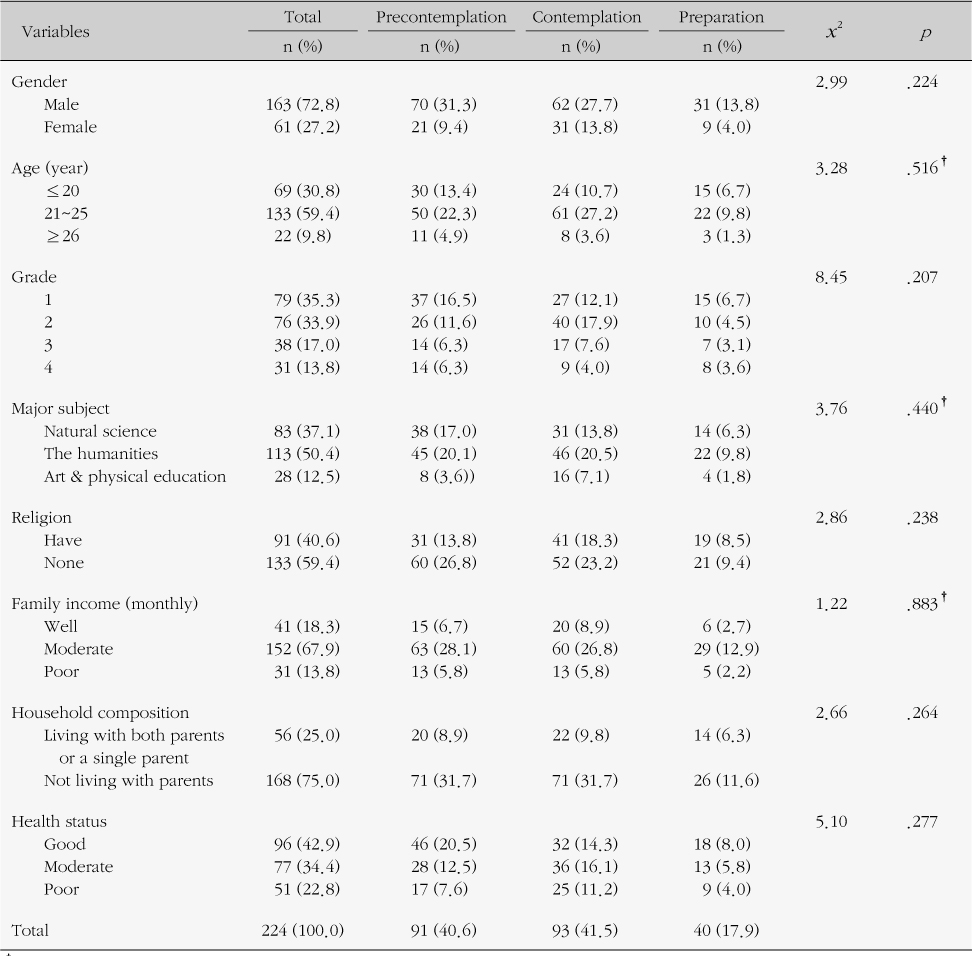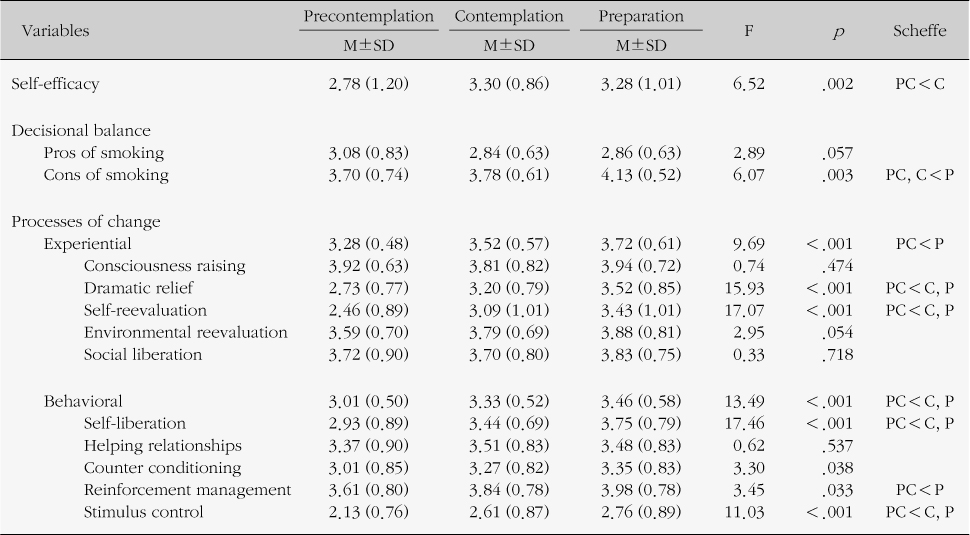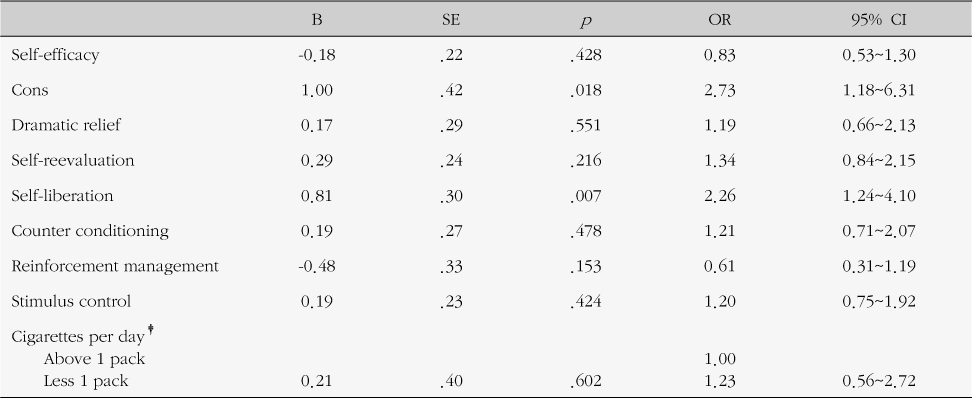References
1. Ahn OH, Yeun E, Kwon SB, Chung HK, Ryu E. Predictive factors of aspects of the transtheoretical model on smoking cessation in a rural community. J Korean Acad Nurs 2005;35(7):1285–1294.
2. Chang SO, Kim EJ, Kil SY, Seomun GA, Lee SJ. Influential Variables on Intention and Action to Quit Smoking between Adolescent Smokers and Adult Smokers-Based on the Transtheoretical Model. J Korean Acad Nurs 2005;35(7):1410–1419.
3. Froelicher ES, Kozuki Y. Theoretical applications of smoking cessation interventions to individuals with medical conditions: Women's initiative for nonsmoking (WINS)-Part III. Int J Nurs Stud 2002;39(1):1–15.
5. Ham OK. Stages and processes of smoking cessation among adolescents. West J Nurs Res 2007;29(3):301–315.
6. Hazen DA, Mannino DM, Clayton R. Gender specific differences in the pros and cons of smoking among current smokers in Eastern Kentucky: Implications for future smoking cessation interventions. Int J Environ Res Public Health 2008;5(4):230–242.
7. Hoeppner BB, Veliver WF, Redding CA, Rossi JS, Prochaska JO, Pallonen UE, et al. Psychometric evaluation of the smoking cessation processes of change scale in an adolescent sample. Addict Behav 2006;31(8):1363–1372.
8. Kim MY, Suh SL, Ham OK. Stages and processes of smoking cessation among high school students in rural community. J Korean Acad Community Health Nurs 2007;18(3):431–440.
9. Kim SJ, Moon SY, Han KS. The actual condition of smoking among university students. J Korean Community Nurs 2002;13(1):147–160.
10. Kim YH. Adolescents' smoking behavior and its relationships with psychological constructs based on transtheoretical model: A cross-sectional survey. Int J Nurs Stud 2006;43(4):439–446.
12. Lee HS. A study on evaluation of effects of juvenile smoking cessation program applied by transtheoretical model Busan: Inje University; 2004. Unpublished doctoral dissertation.
13. Macnee CL, McCabe S. The transtheoretical model of behavior change and smokers in Southern Appalachia. Nurs Res 2004;53(4):243–250.
14. Oh HS, Kim YR. Changing mechanisms corresponding to the changing stages of smoking cessation. J Nurs Acad Soc 1996;26(4):820–832.
15. Oh HS, Kim YR. Factor Analysis on Behavior Change Mechanisms in Self-help Smoking Cessation. J Nurs Acad Soc 1996;26(3):678–687.
16. Oh HS, Kim YR. Exploratory study on developing model for smoking cessation process. J Nurs Acad Soc 1997;27(1):71–82.
17. Otsuki M, Tinsley BJ, Chao RK, Unger JB. An ecological perspective on smoking among Asian American college students: The roles of social smoking and smoking motives. Psychol Addict Behav 2008;22(4):514–523.
18. Pallonen UE. Transtheoretical measure for adolescent and adult smoker: Similarities and differences. Prev Med 1998;27(5 Pt 3):A29–A38.
19. Park NH, Kim JS, Lee YM. Factors associated with the stage of change of smoking cessation behavior in adolescents. J Korean Acad Nurs 2003;33(8):1101–1110.
20. Preston DB, Greene GW, Irwin PA. An assessment of college health nursing practice: A wellness perspective. J Community Health Nurs 1990;7(2):97–104.
21. Prochaska JO, DiClemente CC. Stages and process of self-change of smoking: Toward and integrative model of change. J Consult Clin Psychol 1983;51(3):390–395.
22. Prochaska JO, Velicer WF. The transtheoretical model of health behavior change. Am J Health Promot 1997;12(1):38–48.
23. Prochaska JO, Velicer WF, Diclemente CC, Fava JL. Measuring the processes of change: Applications to the cessation of smoking. J Consult Clin Psychol 1988;56(4):520–528.
24. Prochaska JO, Velicer WF, Rossi JS, Goldstein MG, Marcus BH, et al. Stages of change and decisional balance for 12 problem behavior. Health Psychol 1994;13(1):39–46.
25. Rigotti NA, Moran SE, Wechsler H. US college students' exposure to tobacco promotions: Prevalence and association with tobacco use. Am J Public Health 2005;95(1):138–144.
26. Schüz B, Sniehotta FF, Mallach N, Wiedemann AU, Schwarzer R. Predicting transitions from preintentional, intentional and actional stages of change. Health Educ Res 2009;24(1):64–75.
27. Shin SR, Linda S, Leda D. Tobacco-related education in graduate, baccalaureate and associate degree programs in Korea. J Korean Acad Nurs 2003;33(2):256–264.
28. Son HM. Differences in Processes of Change, Decisional Balance, and Temptation Across the Stages of Change for Smoking Cessation. J Korean Acad Nurs 2005;35(5):904–913.
29. Waters K, Harris K, Hall S, Nazir N, Waigandt A. Characteristics of social smoking among college students. J Am Coll Health 2006;55(3):133–139.
30. Yalçinkaya-Alkar O, Karanci AN. What are the differences in decisional balance and self-efficacy between Turkish smokers in different stages of change? Addict Behav 2007;32(4):836–849.



